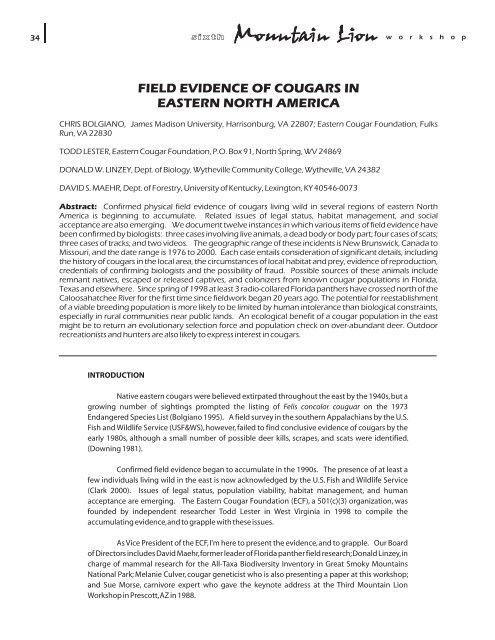PWD BK W7000-893 Proceedings.CDR - Mountain Lion Foundation
PWD BK W7000-893 Proceedings.CDR - Mountain Lion Foundation
PWD BK W7000-893 Proceedings.CDR - Mountain Lion Foundation
You also want an ePaper? Increase the reach of your titles
YUMPU automatically turns print PDFs into web optimized ePapers that Google loves.
34<br />
INTRODUCTION<br />
sixth <strong>Mountain</strong> <strong>Lion</strong> w o r k s h o p<br />
FIELD EVIDENCE OF COUGARS IN<br />
EASTERN NORTH AMERICA<br />
CHRIS BOLGIANO, James Madison University, Harrisonburg, VA 22807; Eastern Cougar <strong>Foundation</strong>, Fulks<br />
Run, VA 22830<br />
TODD LESTER, Eastern Cougar <strong>Foundation</strong>, P.O. Box 91, North Spring, WV 24869<br />
DONALD W. LINZEY, Dept. of Biology, Wytheville Community College, Wytheville, VA 24382<br />
DAVID S. MAEHR, Dept. of Forestry, University of Kentucky, Lexington, KY 40546-0073<br />
Abstract: Confirmed physical field evidence of cougars living wild in several regions of eastern North<br />
America is beginning to accumulate. Related issues of legal status, habitat management, and social<br />
acceptance are also emerging. We document twelve instances in which various items of field evidence have<br />
been confirmed by biologists: three cases involving live animals, a dead body or body part; four cases of scats;<br />
three cases of tracks; and two videos. The geographic range of these incidents is New Brunswick, Canada to<br />
Missouri, and the date range is 1976 to 2000. Each case entails consideration of significant details, including<br />
the history of cougars in the local area, the circumstances of local habitat and prey, evidence of reproduction,<br />
credentials of confirming biologists and the possibility of fraud. Possible sources of these animals include<br />
remnant natives, escaped or released captives, and colonizers from known cougar populations in Florida,<br />
Texas and elsewhere. Since spring of 1998 at least 3 radio-collared Florida panthers have crossed north of the<br />
Caloosahatchee River for the first time since fieldwork began 20 years ago. The potential for reestablishment<br />
of a viable breeding population is more likely to be limited by human intolerance than biological constraints,<br />
especially in rural communities near public lands. An ecological benefit of a cougar population in the east<br />
might be to return an evolutionary selection force and population check on over-abundant deer. Outdoor<br />
recreationists and hunters are also likely to express interest in cougars.<br />
Native eastern cougars were believed extirpated throughout the east by the 1940s,but a<br />
growing number of sightings prompted the listing of Felis concolor couguar on the 1973<br />
Endangered Species List (Bolgiano 1995). A field survey in the southern Appalachians by the U.S.<br />
Fish and Wildlife Service (USF&WS), however, failed to find conclusive evidence of cougars by the<br />
early 1980s, although a small number of possible deer kills, scrapes, and scats were identified.<br />
(Downing 1981).<br />
Confirmed field evidence began to accumulate in the 1990s. The presence of at least a<br />
few individuals living wild in the east is now acknowledged by the U.S. Fish and Wildlife Service<br />
(Clark 2000). Issues of legal status, population viability, habitat management, and human<br />
acceptance are emerging. The Eastern Cougar <strong>Foundation</strong> (ECF), a 501(c)(3) organization, was<br />
founded by independent researcher Todd Lester in West Virginia in 1998 to compile the<br />
accumulating evidence,and to grapple with these issues.<br />
As Vice President of the ECF,I'm here to present the evidence,and to grapple. Our Board<br />
of Directors includes David Maehr,former leader of Florida panther field research;Donald Linzey,in<br />
charge of mammal research for the All-Taxa Biodiversity Inventory in Great Smoky <strong>Mountain</strong>s<br />
National Park; Melanie Culver, cougar geneticist who is also presenting a paper at this workshop;<br />
and Sue Morse, carnivore expert who gave the keynote address at the Third <strong>Mountain</strong> <strong>Lion</strong><br />
Workshop in Prescott,AZ in 1988.
















